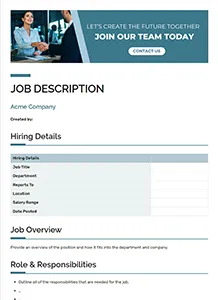The Importance of Strategic Job Descriptions
by Manageable | on September 18, 2025

Hey there! So you might be wondering, why all the fuss about job descriptions? Well, they’re not just formalities anymore – they’re a strategic tool. Think of them as the first handshake between employer and employee. A well-crafted job description can paint a clearer picture of what’s expected, minimizing those “I didn’t know I was supposed to do that!” moments. They’re like the GPS for the employee journey, setting a roadmap for both employees and managers.
When you’ve got strategic job descriptions on your side, setting and managing employee expectations becomes a breeze. They help you communicate what success looks like in that role and align individual contributions with the company’s goals. And let’s not ignore the fact that they can be a vital part of HR tools, providing a consistent framework across recruitment, training, and development.
In essence, they lay the foundation for effective coaching, performance management, and continuous improvement. In today’s fast-paced work environments, such clear directives are goldmines for both employers and employees. So, if you’ve been treating job descriptions as a mere formality, it’s time for a mindset shift!
Creating Clear Expectations
One of the biggest wins with strategic job descriptions is how they nail down clear expectations.
- Clarity: They leave no room for ambiguity, ensuring that everyone’s on the same page.
- Alignment: They align the employee’s goals with the company’s mission.
- Focus: They help employees focus on what’s truly important, avoiding unnecessary tasks.
By defining roles and responsibilities upfront, everyone knows the playbook and what winning looks like. This structured clarity fosters a more proactive and engaged workforce.
Enhancing 1:1 Coaching Sessions
Having strategic job descriptions in your toolkit is like having a personalized coaching manual during 1:1 meetings. These descriptions anchor discussions in facts and expectations, providing a clear baseline to address any challenges or achievements.
With well-defined roles, managers and employees can have honest conversations about performance metrics, development needs, and career aspirations without beating around the bush. Imagine every coaching session being a constructive dialogue rather than a guessing game. Cool, right?
Fostering Continuous Feedback
Feedback – it’s the secret sauce to excellent performance, right? Well, strategic job descriptions can turn every feedback session into a milestone marker. By using them as reference points, feedback becomes more relevant and actionable, directly tied to the outlined responsibilities.
Let’s face it, continuous feedback loops create an agile work environment where employees are constantly learning and improving. They also give employees a voice, encouraging two-way communications where feedback isn’t just top-down. Employees get to express their perspectives too, creating a balanced dialogue.
Moreover, as individuals progress in their roles, regular feedback helps them stay aligned with evolving organizational goals, refining their skills and work habits in real-time. This ongoing loop of feedback, reflection, and adjustment fosters growth not only in jobs but also in careers.
Role in Performance Reviews
Performance reviews can feel like judgment day, but with strategic job descriptions, they’re just a reflection checkpoint of the year. They provide a framework to evaluate how well an individual met the outlined expectations.
Managers can use these descriptions to assess an employee’s contributions truthfully and transparently. This review isn’t just about critiquing; it’s a two-way street, enabling growth conversations and spotlighting achievements. When both parties share clear insights, it leads to more personalized development plans and improved performance management.
In short, strategic job descriptions make performance reviews more objective, focused, and less daunting.
Facilitating Two-Way Communications
Strategic job descriptions don’t just tell but also listen. They bridge gaps by establishing a platform where employees and managers engage in two-way communications. They help build trust and transparency, making it easier to navigate workplace dynamics.
When both sides can discuss and adjust roles and responsibilities openly, it creates a dynamic work environment that adapts to change and inspires next-level creativity. So, don’t just file those job descriptions away – use them to empower and elevate your team!